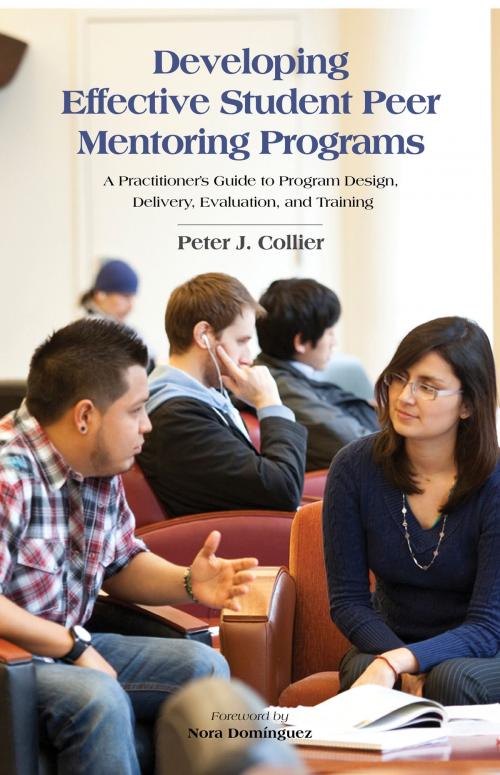Developing Effective Student Peer Mentoring Programs
A Practitioner's Guide to Program Design, Delivery, Evaluation, and Training
Nonfiction, Reference & Language, Education & Teaching, Student & Student Life, Educational Theory, Leadership, Higher Education| Author: | Peter J. Collier | ISBN: | 9781620360781 |
| Publisher: | Stylus Publishing | Publication: | October 31, 2015 |
| Imprint: | Stylus Publishing | Language: | English |
| Author: | Peter J. Collier |
| ISBN: | 9781620360781 |
| Publisher: | Stylus Publishing |
| Publication: | October 31, 2015 |
| Imprint: | Stylus Publishing |
| Language: | English |
This is a comprehensive resource for creating, refining and sustaining effective student peer mentoring programs. While providing a blueprint for successfully designing programs for a wide range of audiences – from freshmen to doctoral students – it also offers specific guidance on developing programs targeting three large groups of under-served students: first-generation students, international students and student veterans.
Collier begins by reviewing the issue of degree non-completion, as well as college adjustment challenges that all students and those in each of the targeted groups face. The book then shifts from the theoretical to the practical by covering the nuts and bolts of developing a college student peer-mentoring program. The author covers a range of design issues and analyzes the strengths and limitations of different program delivery options, from paired and group face-to-face mentoring to their e-mentoring equivalents; offers guidance on the creation of program content and resources for mentors and mentees, and provides mentor training exercises and curricular guidelines.
This book is primarily intended as a resource for student affairs professionals and program coordinators who are developing new peer-mentoring programs or considering refining existing ones. It may also serve as a text in courses designed to train future peer mentors and leaders.
Collier begins by reviewing the issue of degree non-completion, as well as college adjustment challenges that all students and those in each of the targeted groups face. The book then shifts from the theoretical to the practical by covering the nuts and bolts of developing a college student peer-mentoring program. The author covers a range of design issues and analyzes the strengths and limitations of different program delivery options, from paired and group face-to-face mentoring to their e-mentoring equivalents; offers guidance on the creation of program content and resources for mentors and mentees, and provides mentor training exercises and curricular guidelines.
This book is primarily intended as a resource for student affairs professionals and program coordinators who are developing new peer-mentoring programs or considering refining existing ones. It may also serve as a text in courses designed to train future peer mentors and leaders.
This is a comprehensive resource for creating, refining and sustaining effective student peer mentoring programs. While providing a blueprint for successfully designing programs for a wide range of audiences – from freshmen to doctoral students – it also offers specific guidance on developing programs targeting three large groups of under-served students: first-generation students, international students and student veterans.
Collier begins by reviewing the issue of degree non-completion, as well as college adjustment challenges that all students and those in each of the targeted groups face. The book then shifts from the theoretical to the practical by covering the nuts and bolts of developing a college student peer-mentoring program. The author covers a range of design issues and analyzes the strengths and limitations of different program delivery options, from paired and group face-to-face mentoring to their e-mentoring equivalents; offers guidance on the creation of program content and resources for mentors and mentees, and provides mentor training exercises and curricular guidelines.
This book is primarily intended as a resource for student affairs professionals and program coordinators who are developing new peer-mentoring programs or considering refining existing ones. It may also serve as a text in courses designed to train future peer mentors and leaders.
Collier begins by reviewing the issue of degree non-completion, as well as college adjustment challenges that all students and those in each of the targeted groups face. The book then shifts from the theoretical to the practical by covering the nuts and bolts of developing a college student peer-mentoring program. The author covers a range of design issues and analyzes the strengths and limitations of different program delivery options, from paired and group face-to-face mentoring to their e-mentoring equivalents; offers guidance on the creation of program content and resources for mentors and mentees, and provides mentor training exercises and curricular guidelines.
This book is primarily intended as a resource for student affairs professionals and program coordinators who are developing new peer-mentoring programs or considering refining existing ones. It may also serve as a text in courses designed to train future peer mentors and leaders.















